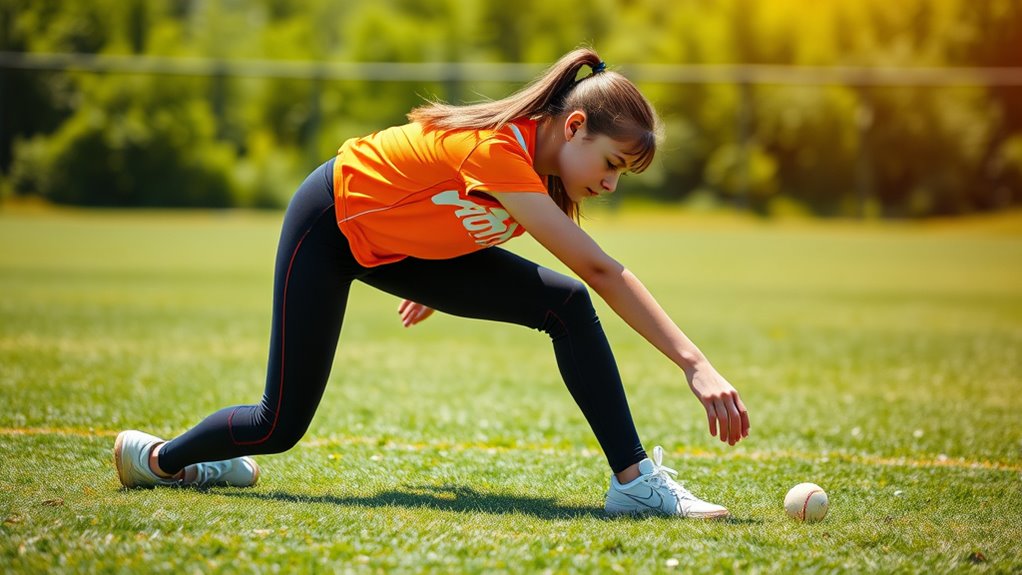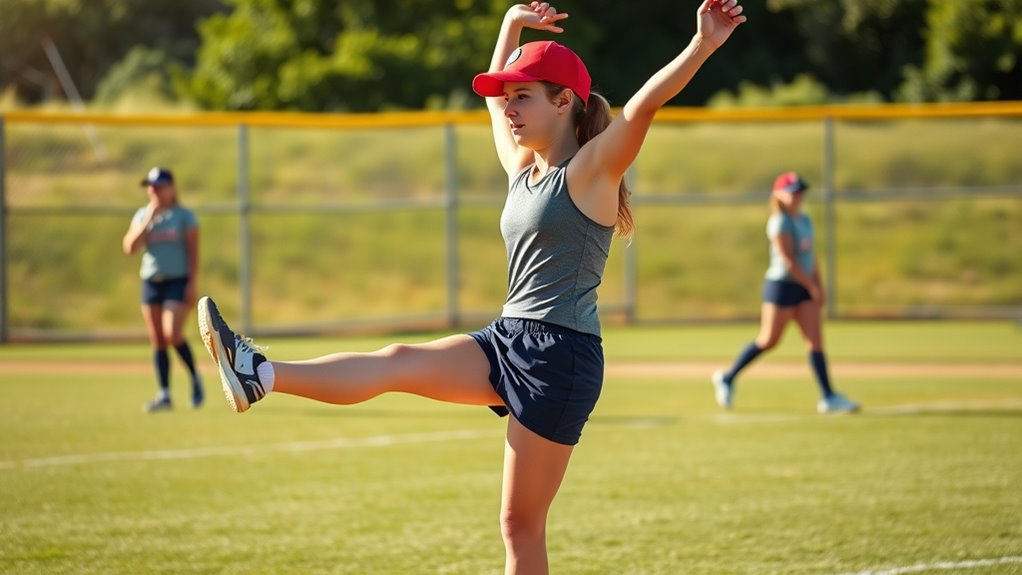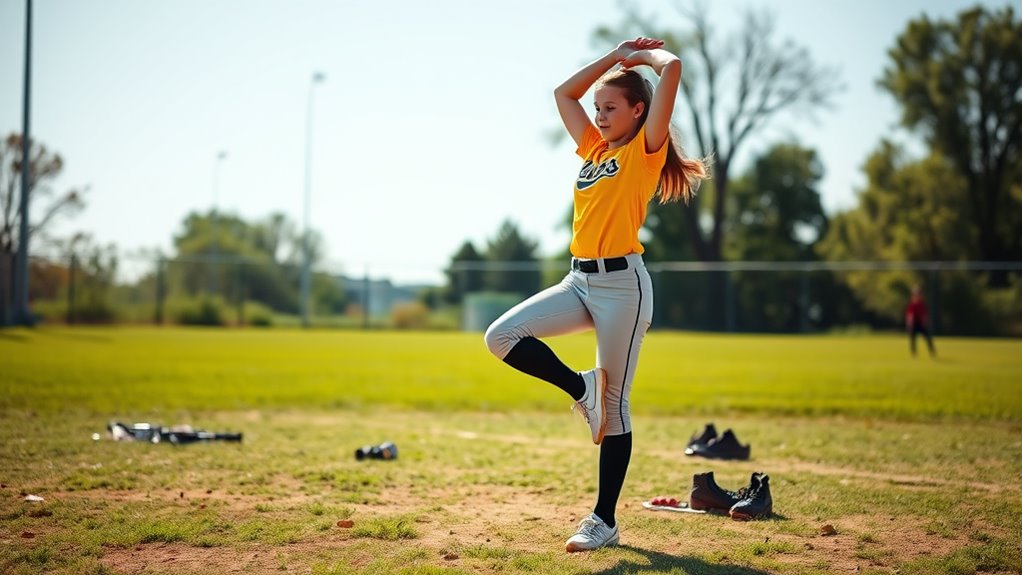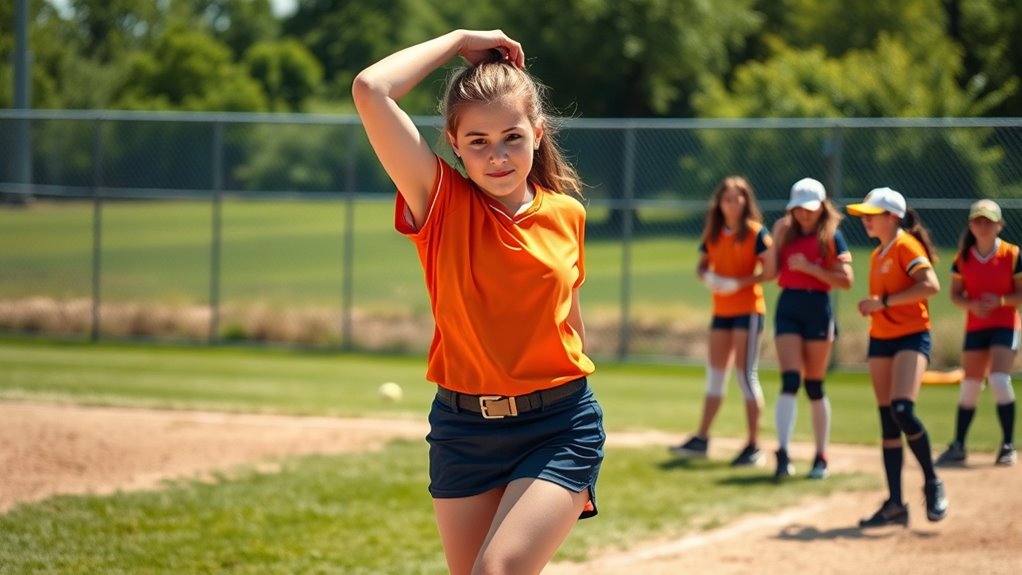To warm up right for softball, start with light cardio like jogging or jumping jacks to get your blood flowing. Follow with dynamic stretches such as arm circles and leg swings to improve flexibility and mobility. Always avoid bouncing or forcing stretches, and focus on controlled movements. Proper warm-ups help prevent injuries and boost your performance. Keep learning more tips here to make your warm-up routine safe, effective, and game-ready.
Key Takeaways
- Incorporate dynamic stretches like arm circles and leg swings before playing to boost mobility and blood flow.
- Use static stretches post-activity to improve flexibility and reduce muscle tension.
- Focus on key muscles such as shoulders, core, legs, and wrists to prevent injuries and enhance performance.
- Avoid bouncing or jerking during stretches; perform slow, controlled movements for safety.
- Include light cardio and glove drills in your warm-up to prepare both your body and hand-eye coordination.
Why Warm-Ups Matter for Softball Success

Warming up before a softball game is essential because it prepares your body for the physical demands ahead. Proper warm-ups improve blood flow, increase flexibility, and reduce injury risk. Equally important is understanding the hydration importance; staying well-hydrated helps maintain your energy levels and prevents cramps during play. When you’re properly warmed up, your mental focus sharpens, allowing you to stay alert and react quickly on the field. This mental clarity boosts confidence and performance, helping you stay engaged throughout the game. Skipping warm-ups can lead to sluggish movements and lapses in focus, negatively affecting your game. Additionally, incorporating mindful decluttering practices into your routine can help reduce mental clutter, allowing you to focus better on your training and gameplay. By dedicating time to warm-up routines, you set yourself up for success and ensure you’re physically and mentally prepared for every play.
Key Muscles to Target Before Playing

Focusing on specific muscle groups before playing can greatly enhance your performance and reduce injury risk. To improve your batting stance and glove handling, target these key muscles:
Target key muscle groups like shoulders, core, forearms, and legs to boost performance and prevent injuries during play.
- Shoulders and rotator cuff – Keep your arms steady and protect against strains during batting and catching.
- Core muscles – Stabilize your body for powerful swings and quick movements.
- Forearms and wrists – Enhance grip strength for better glove handling and bat control.
- Leg muscles (quads and hamstrings) – Support quick starts and stable stances at the plate.
Dynamic Stretching Versus Static Stretching

Understanding the differences between dynamic and static stretching helps you optimize your warm-up and recovery. Dynamic stretches involve movement that can boost performance, while static stretches focus on flexibility and injury prevention. Recognizing how each impacts your body allows you to choose the right approach for your game. Incorporating somatic therapy techniques like mindful movement can further enhance your body awareness and overall athletic readiness.
Movement Types Defined
When it comes to preparing your muscles for softball, knowing the difference between dynamic and static stretching is essential. Dynamic stretching involves active movements that take your muscles through their full range of motion, like arm circles or leg swings. Static stretching, on the other hand, is holding a stretch passively for 15-30 seconds, such as toe touches. Ballistic stretching uses bouncing movements to push muscles beyond their usual range, but it can cause injury if not done carefully. Passive stretching involves relaxing muscles while an external force, like gravity or a partner, stretches the muscle. To clarify:
- Dynamic stretching activates muscles for movement.
- Static stretching improves flexibility and cool-down.
- Ballistic stretching involves bouncing motions.
- Passive stretching relies on external force for stretch.
Performance Impacts Differ
Dynamic and static stretching each affect your performance in different ways. Dynamic stretching helps increase your mental focus by activating muscles and boosting blood flow, preparing you for quick movements on the field. It also promotes team cohesion when done in groups, enhancing communication and coordination. Static stretching, on the other hand, is better suited for cooling down after practice, as it improves flexibility over time. However, holding stretches before playing can reduce muscle power and agility, potentially hindering your performance. By understanding these impacts, you can tailor your warm-up to maximize mental focus and team cohesion during gameplay. Incorporating dynamic stretches before games and static stretches afterward ensures you’re physically ready and mentally prepared for each softball session. Additionally, using proper stretching techniques can help prevent injuries and improve overall athletic performance.
Injury Prevention Strategies
Injury prevention is a crucial reason to incorporate proper stretching into your softball routine, and choosing the right type makes a difference. Dynamic stretching warms up muscles and enhances field agility, reducing injury risk. Static stretching, done after activity, can improve flexibility but may decrease muscle power temporarily. To protect your bat speed and agility, consider these strategies:
- Use dynamic stretches like leg swings and arm circles before games to activate muscles.
- Focus on mobility drills that mimic on-field movements.
- Save static stretches for post-game to improve flexibility without sacrificing performance.
- Regularly incorporate both types to support muscle health and prevent strains.
- Incorporating proper warm-up techniques such as targeted stretching routines can further optimize your readiness and reduce injury risk.
Balancing dynamic and static stretching helps you stay injury-free, maintain essential bat speed, and stay agile on the field.
Top Dynamic Stretches for Softball Players

To get your muscles ready, start with arm circles to loosen your shoulders. Leg swings help activate your hips and legs, boosting your mobility. Finish with hip rotations to increase joint flexibility and prepare for the game.
Arm Circles Warm-Up
Arm circles are an effective way to warm up your shoulders and increase blood flow before hitting the field. They help improve shoulder mobility, which is essential for powerful throws and quick reactions. To get started, follow these steps:
- Stand tall with arms extended outward, parallel to the ground.
- Make small circles forward, gradually increasing the size.
- Switch directions, doing large circles backward.
- Repeat for 10-15 seconds each way to guarantee your shoulder muscles loosen up.
This simple movement activates the shoulder muscles and enhances mobility, reducing injury risk during gameplay. Incorporate arm circles into your warm-up routine to prepare your shoulders for the demands of softball. Proper shoulder mobility is key to executing accurate throws and swinging with power.
Leg Swings Activation
Leg swings are an essential dynamic stretch that help activate your hip flexors, hamstrings, and glutes before playing. Incorporate leg swings into your warm-up as part of effective activation drills to prepare your muscles for action. Start by holding onto a stable surface for balance, then swing one leg forward and backward in a controlled motion. Keep your movement smooth and controlled, focusing on range of motion rather than speed. Switch legs and repeat for about 10-15 swings each side. This exercise increases blood flow, loosens tight muscles, and enhances mobility, reducing injury risk during gameplay. Make leg swings a regular part of your warm-up routine to ensure your lower body muscles are primed for quick movements and powerful plays. Additionally, focusing on proper muscle activation techniques can further improve your overall performance on the field.
Hip Rotations Mobilize
Ever wonder how to smoothly loosen up your hips before stepping onto the field? Hip rotations are key to boosting your hip mobility and improving joint flexibility. To do this effectively, follow these steps:
- Stand tall with feet shoulder-width apart.
- Lift one knee to hip level, then rotate your leg outward in a circular motion.
- Repeat for 10-15 rotations, then switch legs.
- Keep your torso steady and engage your core for better control.
This dynamic stretch targets your hip joints, helping you move more freely and reduce injury risk. Incorporating hip rotations into your warm-up enhances overall mobility, preparing your hips for quick, powerful movements essential in softball. Consistent practice will make your hips more flexible and responsive on game day. Proper warm-up techniques can further improve your performance and prevent injuries.
Simple Static Stretches to Incorporate

Incorporating simple static stretches into your routine can substantially enhance flexibility and reduce injury risk. These stretches improve breath control and boost mental focus, helping you stay present during practices and games. Focus on holding each stretch gently, breathing deeply to deepen the stretch and calm your mind. Consider these effective stretches:
| Stretch | Target Area | Tips |
|---|---|---|
| Hamstring Stretch | Back of thighs | Keep your back flat, breathe slowly |
| Quadriceps Stretch | Front of thighs | Pull gently, stay balanced |
| Shoulder Stretch | Shoulders and arms | Relax your neck, steady breath |
Engaging in these stretches with proper technique can also improve your overall timing and delivery during gameplay.
Creating an Effective Warm-Up Routine

A well-designed warm-up routine prepares your muscles and mind for the upcoming game or practice, reducing the risk of injury and improving performance. To create an effective routine: 1. Start with light cardio, like jogging or jumping jacks, to increase blood flow. 2. Incorporate dynamic stretches to loosen muscles and improve flexibility. 3. Practice glove work to refine hand-eye coordination and get comfortable in your glove. 4. Include drills focused on bat speed, such as soft toss or tee work, to enhance swing quickness. Additionally, integrating proper nutrition can support muscle readiness and energy levels for optimal performance.
Common Mistakes to Avoid When Stretching

One common mistake players make when stretching is pushing too hard or bouncing, which can cause muscle strain or injury. This leads to overstretching pitfalls that weaken your muscles instead of loosening them. Using improper technique, like jerking into stretches or holding them too aggressively, increases your risk of strains and tears. Avoid the temptation to force your body into uncomfortable positions; stretching should be gentle and controlled. Overstretching can damage muscle fibers and reduce flexibility rather than improve it. Focus on slow, steady movements, and listen to your body’s signals. Remember, effective stretching isn’t about pushing to the limit but about gradually increasing flexibility safely. Proper technique and awareness of your body’s limits can prevent injuries and ensure your warm-up is both effective and safe.
Tips for Staying Safe During Your Warm-Up

To stay safe during your warm-up, focus on gradually increasing your intensity and paying attention to how your body feels. This helps prevent injuries and prepares you for the game. Keep these tips in mind:
- Hydration reminders: Drink small amounts of water regularly to stay hydrated, especially if it’s hot or humid.
- Listen to your body: Stop if you experience pain or discomfort, and adjust your intensity accordingly.
- Use proper techniques: Perform each movement with control to avoid overstretching or straining muscles.
- Incorporate cool down routines: After warming up, gently stretch and hydrate to aid recovery and prevent stiffness.
- Be mindful of sound healing science, as incorporating calming sounds during warm-up can help enhance focus and relaxation.
Staying mindful of these tips ensures a safe and effective warm-up, setting you up for a successful game.
Incorporating Stretching Into Your Regular Practice

Incorporating stretching into your regular practice helps improve flexibility, reduce injury risk, and enhance overall performance. To make it effective, set aside time after each session for targeted stretching routines. Remember to stay hydrated—hydration tips like drinking water before, during, and after practice keep your muscles pliable and ready. This also boosts your mental focus, helping you stay engaged and mindful during stretches. Consistency is key, so aim to stretch daily or at least several times a week. Incorporate dynamic stretches before practice to warm up and static stretches afterward to improve flexibility. By integrating these habits, you’ll build a routine that supports your growth as a player, minimizes injuries, and sharpens your mental clarity on the field.
Frequently Asked Questions
How Long Should My Warm-Up Last Before Starting Softball Practice?
Your warm-up should last about 15 to 20 minutes before starting softball practice. This helps you establish effective pre-game routines and reduces injury risk. Focus on dynamic stretches and light cardio to get your muscles ready. A proper warm-up increases flexibility, boosts performance, and prevents strains. Don’t rush; a well-structured routine sets the tone for a safe, successful game.
Can Stretching Improve My Batting Power and Accuracy?
Stretching can definitely improve your batting power and accuracy by enhancing your batting muscle flexibility. When you incorporate regular flexibility training, you loosen tight muscles, allowing for a smoother swing and better control. Proper stretching before practice increases blood flow and prepares your body for effort, helping you generate more force and precision. So, yes, consistent stretching is a key part of boosting your overall batting performance.
When Is the Best Time to Do Static Versus Dynamic Stretches?
Did you know that dynamic stretching increases muscle activation and prepares your body for activity, reducing injury risk? You should do dynamic stretches before playing to loosen muscles and improve movement. Save static stretches for after your game or practice, when your muscles are warm, to enhance flexibility and prevent injuries. Timing matters—dynamic first, static later—to keep you safe and perform your best on the field.
Should I Stretch if I Feel Sore or Tired Before Playing?
If you’re sore or tired before playing, it’s best to skip intense stretching and focus on gentle movements. Incorporate these into your pre-game rituals to help prevent injury and boost performance. Light dynamic stretches can increase blood flow and loosen muscles without overexerting yourself. Listening to your body is key—if something feels wrong, prioritize rest or light activity to stay injury-free and ready for the game.
How Can I Tell if I’M Stretching Correctly and Safely?
To tell if you’re stretching correctly and safely, pay attention to proper technique by avoiding bouncing and stretching to the point of pain. You should feel a gentle tension, not discomfort. Keep movements controlled and hold each stretch for about 15-30 seconds. Doing so helps prevent injuries and guarantees you’re stretching effectively. Always listen to your body and stop if you experience sharp pain, prioritizing injury prevention during your warm-up.
Conclusion
By mastering these stretching techniques, you’ll open your full softball potential and become an unstoppable force on the field. Skipping warm-ups is like trying to start a race with a flat tire—you’re just asking for trouble. So, make stretching a non-negotiable part of your routine. With consistent effort, you’ll boost your performance, prevent injuries, and dominate every game like a true softball superstar. Get ready to stretch your way to greatness!









